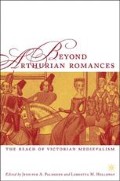Abstract
The medieval performance structure that lay at the heart of the nineteenth-century embrace of medievalism was the tournament, and perhaps the key factor in the ease with which Victorians played at and played with the medieval tournament was the essentially performative and doubled nature of the original event. Louise Fradenburg’s account in City, Marriage, Tournament: Arts of Rule in Late Medieval Scotland1 of the way in which monarchs used the performance space of the tournament field variously for public entertainment, personal recreation, military training, political maneuvering, diplomatic dialogue, and settling serious disputes makes clear that role play and the taking on of symbolic and idealized personae were key elements in the construction of tournaments.2 Nineteenth-century authors, particularly Sir Walter Scott, understood and utilized this aspect of tournaments in shaping their narratives, and it was recognized and embraced by nineteenth-century participants in recreations.
Access this chapter
Tax calculation will be finalised at checkout
Purchases are for personal use only
Preview
Unable to display preview. Download preview PDF.
Notes
Louise O. Fradenburg, City, Marriage, Tournament: Arts of Rule in Late Medieval Scotland (Madison: University of Wisconsin Press, 1992).
A. H. Saxon, Enter Foot and Horse (New Haven; London: Yale University Press, 1986), 6.
K8 in Richard Ford, Dramatisations of Scott’s Novels: A Catalogue (Oxford: Oxford Bibliographical Society, 1979).
James Chandler, England in 1819: The Politics of Literary Culture and the Case of Romantic Historicism (Chicago: University of Chicago Press, 1998).
S. Barczewski, Myth and National Identity in Nineteenth-Century Britain: The Legends of King Arthur and Robin Hood (Oxford: Oxford University Press, 2000).
Sir Walter Scott, Ivanhoe (Harmondsworth; New York: Penguin. Penguin Classics, 1986), 508.
F. Fox Cooper, Ivanhoe (London: Dick’s British Drama 1883 no. 385). K18 in Ford’s catalogue.
Ian Anstruther, The Knight and the Umbrella (London: Geoffrey Bles, 1963).
R. B. Martin, “Plum’d like Estriches,” Enter Rumour. Four Early Victorian Scandals (London: Faber and Faber, 1962), 83–136.
J. E. Adams, Dandies and Desert Saints: Styles of Victorian Manhood (Cornell: Cornell University Press, 1995).
Lynda Nead, Victorian Babylon (New Haven; London: Yale University Press, 2000).
M. Girouard, The Return to Camelot: Chivalry and the English Gentleman (New Haven; London: Yale University Press, 1981).
At the last the general populace might have lost sight of the origins of the splendid spectacles that were the steam gallopers in full flow, but the fairground community remembered and in 1928, the American National Association of Amusement Parks passed a resolution in praise of a noted carousel maker who had recently died: The knights of old rode their magnificently caparisoned horses only in defense of themselves and their honor and to what they thought is [sic] their lasting way of fame. Our member produced a finer caparisoned horse than the world had known up to his time, and best of all, it was produced to give joy to the millions, and any man who made his fellow man happy, cannot be said to have lived his life in vain. Quoted in F. Fried, A Pictorial History of the Carousel (New York: A.S. Barnes and Co., 1978). The maker was William H. Dentzel.
Editor information
Copyright information
© 2005 Lorretta M. Holloway and Jennifer A. Palmgren
About this chapter
Cite this chapter
Bell, B. (2005). The Performance of Victorian Medievalism. In: Holloway, L.M., Palmgren, J.A. (eds) Beyond Arthurian Romances. Palgrave Macmillan, New York. https://doi.org/10.1057/9781403981165_11
Download citation
DOI: https://doi.org/10.1057/9781403981165_11
Publisher Name: Palgrave Macmillan, New York
Print ISBN: 978-1-349-53006-9
Online ISBN: 978-1-4039-8116-5
eBook Packages: Palgrave Literature & Performing Arts CollectionLiterature, Cultural and Media Studies (R0)

